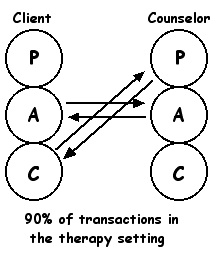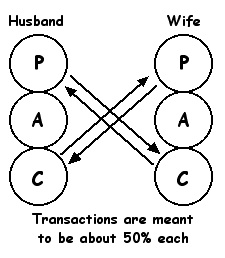I have written before about the process of transference that the client and therapist go through.

As one can see it includes what is called the positive and negative transference. Those are the stages where the client can have quite strong feeling reactions to the therapist. In the positive transference that usually includes the liking, loving and even at times erotic feelings.
This period can vary enormously in duration. Some times it is quite short and other times it lasts for long periods. One aspect of this is the attachment changes that occur during these phases.

In the positive transference the attachment develops and in the negative transference the attachment is broken down as the psychological separation occurs.
When the client switches to the negative transference they stop being friendly, helpful, agreeable and so forth and become disagreeable and argumentative. This can include arguing about the bills, changing appointments, getting appointment times wrong and so forth.
As regards the emotional quality of this stage I came across a blog post the other day. It was an open letter that had been written from a client to her therapist. I found it captured the emotional quality of the negative transference very well and I will use it in future as a teaching piece and hence I am writing about it here. It goes as such:

“Dear J,
I’m feeling angry about therapy. Here are some of the reasons why:
You always start the session by asking, “So what are we talking about today?” even if it is very obvious what needs to be talked about.
Every week feels like the first week all over again, instead of accumulating knowledge about me and reflecting back.
There is never any silence; I like to have silence occasionally.
I trusted you to read my blog and you searched for “sex” and “job” and then lied about it.
I gave you a really long account of 2009 and you said there was enough material in there to last for a few weeks of therapy and you never brought it up again.
You try to make everything logical and rational and then I feel guilty and I feel like a failure that it’s not sinking in.
You don’t pick up on what I need or what I feel. You never ask me what I need. I don’t even know what I need, but maybe if you ask me I’ll try to figure it out.
You once said in an email, “I think that one needs to work through or resolve issues in order to avoid repeating them.” All I feel like I’m doing is repeating the same things over and over and over.
Your office is so damn beige.
Tags: anger”
(end quote)
To summarise the grievances:
She questions his therapeutic skills
He is told he lied which implies he is also unreliable and untrustworthy
She reports he made her feel bad in this case guilty and a failure
He is told he does not give her what she wants, in this case silence
But it is best summed up in her last comment about the beige office. Translated = “I am angry at you”, as her tag so accurately portrays.
One of the difficulties of defining this as negative transference is the client can take it to mean that their feelings of anger are not real or are somehow invalid. That is not the case as the client feels what they feel and they are real and valid.

However the feelings are out of proportion to what is going on in the here and now because the client is misperceiving the therapist. It is a situation of misperception not ‘unreal’ emotions. I didn’t call it a problem of misperception because such misperceptions can lead to therapeutic gain if handled correctly by the therapist. The misperception is a positive thing in this sense.
If a client states they they have strong feelings for or are in love with the therapist that of course is great for the therapist’s ego. It’s great to think that I must be so attractive that someone has such feelings for me. But alas it is not so. A client does not fall in love with me they fall in love with what I represent to them.
How can you love someone when you hardly even know them? The client therapist relationship is a very specific and restricted one. The client only gets to see the therapist in a very singular way, that is in a sympathetic, understanding, reliable, caring role. The transactions would usually be as such:

In the therapy setting these transactions would most often occur 90% of the time. This is very different to the usual male and a female relationship which in part could be drawn as such:

Whether they be just friends or married both parties are supposed to express their Child ego state wants and needs about 50% of the time. In addition they are meant to be caring of each other about equal amounts as well. Both sides get to see the other’s Child ego state in particular. Thus they know them more ‘deeply’ than a client can know a therapist as the therapist very infrequently expresses such child needs to the client.
Thus the client does not really get to know the therapist even though the level of emotional reaction in the transferences would indicate that they do. In the positive transference the client unconsciously fills in the gaps that they do not know about the therapist thus giving them the perception that they know the person well.

If you go back to that letter one finds a lot of ‘gap filling in’ being done but in a negative transference way in that case. A good deal of therapist motivations and meaning to his perceived behaviour are added in such as about the silence. Also no therapist is that bad. In the letter none of his good points are being acknowledged.
For many years my parents an I ran a counselling training institute together. They were both psychologists and trainers like I was, and we trained many hundreds of people. Not uncommonly over the years a trainee and/or client of theirs would take me aside and tell me how lucky I was to have been raised with such healthy parents. I would just look a bit stunned, (as I was), smile blankly and change the topic.
Now my parents were OK as parents but they were far from perfect, god rest their souls. The client/trainee was in a positive transference and had filled in the gaps about them without even knowing it.
Graffiti




0 comments:
Post a Comment